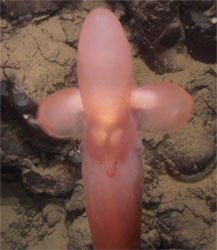06.10.2008 - Success at Sea
According to Centre leader, Rolf-Briger Pedersen, frontier research such as that in the areas of deep sea, deep bio-sphere, zero-time (deep time) is risky business, but this year the field activities have paid off!
Main content
Leg 2 – Jan Mayen
Preliminary results seem to indicate that the hydrothermal fields near Jan Mayen are both more extensive and more active than previously believed. Taking advantage of this unique natural laboratory, CGB researchers collected incubators that had been set out in 2006 in various ecological settings in different parts of the two fields and set out a series of new incubators.
The different ecological settings for the 2006 incubators included iron-hydroxide mounds, sulphur-reducing areas around chimneys, and extreme areas within chimneys. Growth was extensive at all three sites indicating that this is clearly an area of vigorous geobiological activity. For example, one drawer-full of sediments gave a temperature reading of 90°C after it was tested back on board ship!
Leg 3 - Nyegga
During the survey and sampling efforts in the mid-Norwegian margin at Nyegga, CGB researchers and researchers from the Department of Earth Science mapped gas hydrate locations, took samples of the hydrate and collected biological samples. Analysis of the data from this natural laboratory setting will contribute significantly to our understanding of cold seep and gas hydrate reserves. (GANS project)
Professor Haflidi Haflidason was cruise leader for Leg 3. He underlined the importance of the multi-disciplinary research efforts on the cruise. Not only does such collaboration involve a cost-effective efficiency in terms of equipment use, but it also leads to a better and more systemic understanding of frontier phenomena, such as cold seeps and hydrate deposits.
Leg 1 – Loki’s Castle
The highlight of the summer’s finds, however, was the discovery of a significant hydrothermal field with black smokers at the edge of the Arctic Ocean. Like the previous fields at Jan Mayen, the find clearly demonstrates that significant venting activity can occur along slow- and even ultra slow-spreading ridges. Located over 2km deep, the field is not only expansive in terms of mineral deposits but appears to be associated with a unique vent fauna, unlike that found near vents further south in the Atlantic and elsewhere.
The Loki’s Castle field is also unique in the world because this part of the mid-oceanic ridge system is also sedimented. Sediment studies provide unique aging and chemical information that can set local venting and other geological activities in a time perspective.
The find is a culmination of ten years of research and the field was therefore named Loki’s Castle after a minor Norwegian god renowned for his trickery. There have been numerous reports of the find in both the national Norwegian press and internationally.




